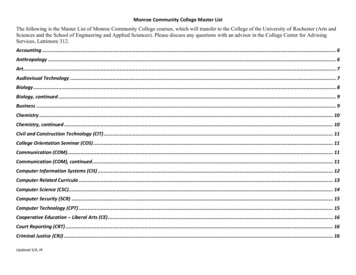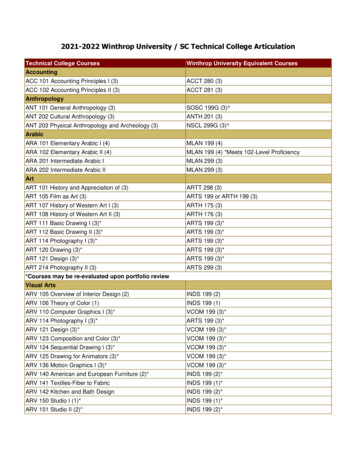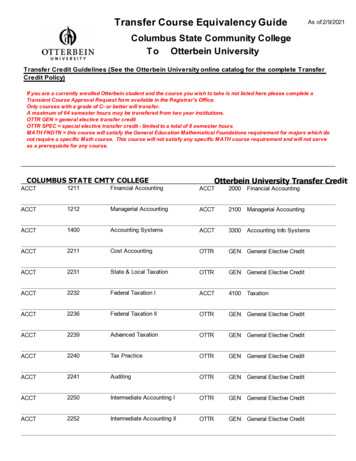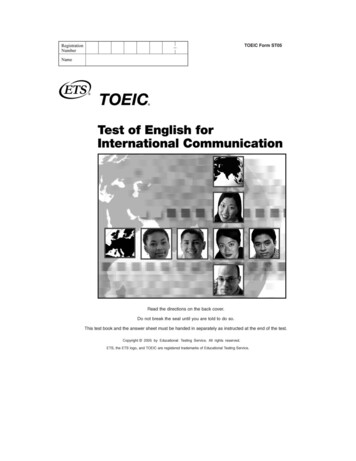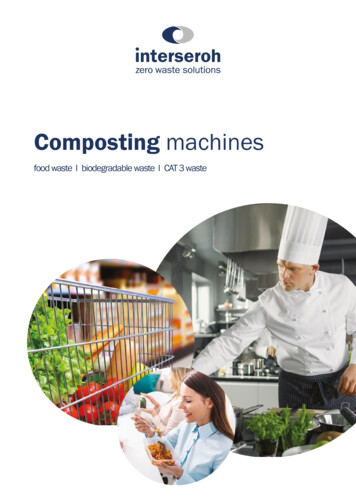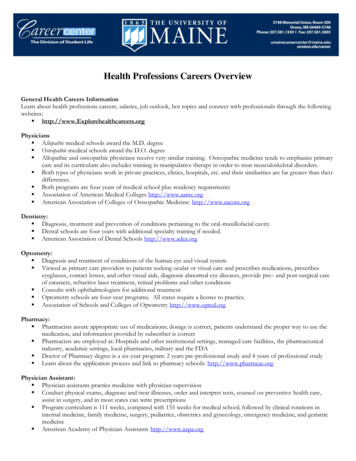
Transcription
BIO-PROCESS LAB ANSWER KEYBy: Rexana Chen
Label the microscope:1. Ocular2. Nosepiece3. Objective4. Stage5. Stage clips6. Base7. Diaphragm8. Illuminator9. Coarse adjustment10. Fine adjustment11. ArmIdentify the following Lab Equipment:12. Litmus Paper
13. Triple Beam Balance14. Calipers15. Bunsen BurnerMagnification:16. What is the formula for magnification?Magnification size of image/size of specimen17. The size of an image is 9 centimeters and the specimen is 0.9 micrometers.What’s the magnification? Show your work.Magnification 9 centimeters/0.9 micrometersMagnification 90000 micrometers/0.9 micrometers
Magnification 100,00018. The size of a specimen is 100 nanometers and the image is 0.1 meter.What’s the magnification? Show your work.Magnification 0.1 meter/100 nanometersMagnification 100,000,000 nanometers/100 nanometersMagnification 1,000,00019. The size of a specimen is 10 kilometer and the image is 1 megameter. What’sthe magnification? Show your work.Magnification 1 megameter/10 kilometerMagnification 1,000 kilometer/10 kilometerMagnification 100Food Webs:*Use this image for questions 20 - 25*20. Producer(s): “green plant”21. Herbivore(s): “goat, rabbit, mouse”22. Carnivore(s): “lion, jackal, wild cat, kite, snake, owl, rabbit”23. Omnivore(s): “rabbit”
24. What animals are the highest order consumers on this food web?Lion, Kite, Owl25. Make one food chain from the food web:Ex: Green plant - goat - jackal - lion*other possible food chains are counted*26. Detritivores are often such as , , .Detritivores are often invertebrate insects such as mites, beetles, butterfliesand flies. (or anything else that’s true)Population density and ecological analysis:*Use this image for questions 27 - 29*27. What type of pattern distribution is this?Clumped28. This type of distribution happens when .This type of distribution happens when there is a patchy distribution ofresources29. True/False This population distribution is the most common.
*Use this image for questions 30 - 32*30. What type of pattern distribution is this?Uniform31. This pattern of distribution is typical in species in which ?This pattern of distribution is typical in species in which individuals competefor a scarce environmental resource.32. Describe an example of an plant or animal that have this type ofdistribution:Desert shrubs competing for water (or anything else that’s true)*Use this image for questions 33 - 35*33. What type of pattern distribution is this?Random34. This is typical of species in which individuals ?This is typical of species in which individuals do not interact strongly35. Describe an example of an plant or animal that have this type ofdistribution:
Plants with wind-dispersed seeds, such as dandelions (or anything elsethat’s true)36. A suckerfish attaches to the side of a shark, traveling with the shark andfeeding on the shark's leftover food. The sharks are unaffected.Which best defines the ecological interaction between the shark and ionMutualism37. A plant is pollinated by a moth. The moth lays its eggs in the flowers forprotection and food.Which best defines the ecological interaction between the plant and utualism38. Two plants growing beside one another try to access limited availablesunlight.Which best defines the ecological interaction between the two tualism39. Changes in the lion population are shown below:2020: 500
2021: 5372022: 5682023: 6002024: 6682025: 7002026: 7112027: 7102028: 711Why did the size of the lion population remain relatively constant from2026-2028?a. there is a lack of prey due to the population increase over timeb. there is a new disease that is killing off some lionsc. There’s a new predatord. The population has reached its carrying capacity40. A population of birds eat worms. Over time there were more worms thanusual. What will most likely happen due to this increase of worms?a. The population increasesb. The birds expand their territoryc. The population decreasesd. The population has fewer predators41. Which of the following suggests population increase?a. increase in younger population membersb. Increased ratio between birth rate and death ratec. More resource competitiond. Increase in offspring survival rateIndicators42. What do Benedict’s Tests detect?Reducing sugars43. What does it mean when the liquid is blue in a Benedict’s Test?No reducing sugar is present44. What does it mean when the liquid is orange in a Benedict’s Test?Moderate amount of reducing sugar is present (1.5-2% sugar)
45. Does complex carbohydrate give positive results in Benedict’s test?Yes/No47. How is Lugol's iodine used as an indicator?It turns black in the presence of starch47. What color is a negative test (for Lugol’s iodine)?Red/orangeHeredity*Use this karyotype for questions 54 - 56*48. What is the gender of this individual?Male49. What is the condition of this individual?Patau syndrome50. What are 3 symptoms of this condition?
Clenched hands, Cleft lip or palate, Extra fingers or toes (polydactyly),Hernias, Kidney, wrist, or scalp problems, Low-set ears, Small head(microcephaly), Undescended testes, Breathing difficulties, Congenital heartdefects, Hearing loss, High blood pressure (hypertension), Intellectualdisabilities, Neurological problems, Breathing problems, Seizures, Slow growth,Trouble feeding or digesting foodFor the following template strand of DNA:3’- ATG AGA CCT CAG CGT TTC -5’51. List the corresponding mRNA strand5’- UAC UCU GGA GTC GCA AAG -3’52. List the corresponding tRNA strand3’- AUG AGA CCU CAG CGU UUC -5’53. List the corresponding amino acid chain5’- Met Arg Pro Gln Arg Phe -3’Is it a phenotype or genotype?54. Eye color (phenotype)55. Ee (genotype)Black hair is dominant and brown is recessive. Peppa’s mom’s genotype is bb.Peppa’s dad's genotype is Bb. What is Peppa’s genotype and phenotyperatio?56. Genotype: 50% Bb (heterozygous) 50% bb (homozygous recessive)57. Phenotype: 50% Black hair 50% Brown hairBrown eyes are dominant and green eyes are recessive. Peppa’s brother,George, has green eyes. If both his parents have brown eyes, what are theirgenotypes and how can George have green eyes?58. Genotype: mom: Gg dad: Gg59. How can George have green eyes when both his parents have brown?
Brown eyes are dominant, so the recessive green eye gene does not showeven if you have a green eye gene. In this case, both his parents had a greeneye gene, but they had brown eyes because they are dominant. In order forGeorge to have green eyes he needs to inherit the green eye gene from bothhis parents which is possible since they both have a green eye gene.*use this pedigree for questions *60. Is this trait dominant or recessive? Why?This trait is recessive as it skips generation and dominant traits don’t skipgenerations.61. Will the child of generation 4 (1) and Generation 4 (2) have the trait?No62. How do you know? (look at question 68)We know that the trait is recessive, so Generation 4(1) has to have a genotypeof aa in order to have that trait. If we make a punnett square, you can seethat all the outcomes of crossing AA and aa is Aa. The A is dominant, so therecessive trait will not show.63. Make a punnett square: (look at question 68)Punnett SquareaaAAaAaAAaAa64. What is the relationship between generation 3 (4) and generation 3 (5)?They are cousins65. A blue and yellow flower cross to make a green flower. What type ofdominance is this?Incomplete dominance
66. A blue and yellow flower cross to make a striped blue and yellow flower.What type of dominance is this?Codominance67. What is the function of the Golgi Apparatus?process and package proteins and lipid molecules68. What is the function of the smooth and rough Endoplasmic Reticulum?In the rough ER, ribosomes are found (perform protein synthesis). In thesmooth ER, molecules such as hormones and lipids are synthesized.69. What type of enzymes use water to break chemical bonds?hydrolytic enzymes70. In what step of mitosis is the spindle apparatus synthesized?Prophase71. Mitosis is complete after which stage?Cytokinesis72. Bacteria and Archaea are botha. Unicellular prokaryotesb. Unicellular eukaryotesc. Multicellular prokaryotesd. Multicellular eukaryotese. They’re different73. The cell wall surrounds which of the following?a. Plantsb. Fungic. Prokaryotic cellsd. All of the aboveFood Label Questions
74.a) Total calories from carbs 184b) Total calories from protein 44c) Total calories from fats 3675. What is the DV of the following nutrients according to the label? (Round tothe nearest whole)a) vitamin D 20b) Calcium 1300c) iron 17d) Potassium 400076. How many total calories per container of the following thing?a) Carbohydrates 736b) Protein 176
c) Fat 144
Identify the following Lab Equipment: 12. Litmus Paper. 13. Triple Beam Balance 14. Calipers 15. Bunsen Burner Magnification: 16. What is the formula for magnification? Magnification size of image/size of specimen 17. The size of an image is 9 centimeters and thespecimen is 0.9 micrometers. . Pickles' Bio-Process Lab Answer Key .
